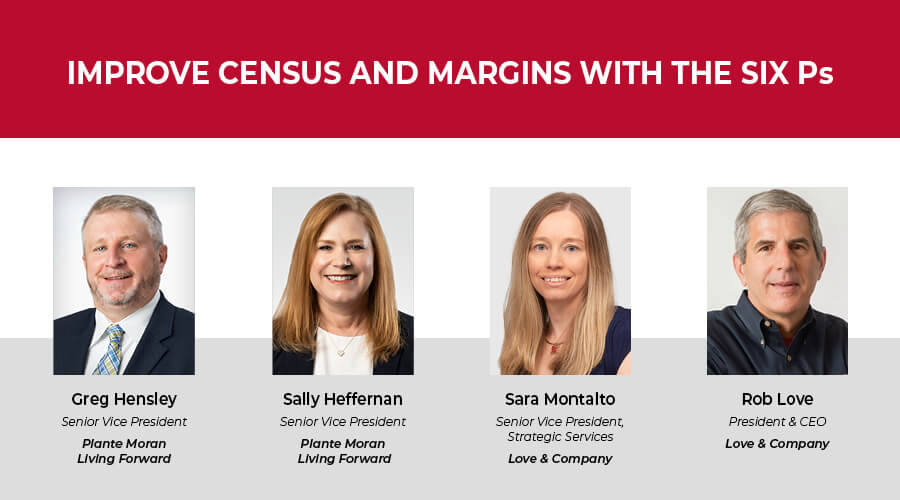Part I: How Place, Product and Price stimulate success in senior living.
This month, as part of our continuing webinar series, we’ll team with Sally Heffernan and Greg Hensley of Plante Moran Living Forward (PMLF) to discuss Six Ps—key steps that can help maximize marketability and occupancy in today’s competitive senior housing market.
The Six Ps are:
- Place (the external market)
- Product (physical plant and amenity and service offerings)
- Price (monthly service fees and entrance fees)
- Planning (financial strategy for phasing improvements and strengthening the organization for growth)
- Promotion (marketing and sales)
- Performance (operations)
In this, Part I of a two-part series, we look at Place, Product and Price to see why they’re important.
Place: A mixture of micro markets?
A community’s location, of course, is a critical factor in its ability to attract residents. With today’s rapid growth in the population of age- and income-qualified prospects, communities have more opportunities to grow than ever. But where should that growth happen? Should it be on your existing campus, assuming you even have space? Or should you explore additional locations for a new or satellite community?
For all communities, there’s a process that helps determine where to grow. Sally Heffernan, senior vice president of PMLF, notes, “A lot of existing communities are 30 or more years old, so defining the best place for growth requires some work. Identify pocket markets. Compare demand and demographics in various pockets to supply. Look at penetration rates and underserved ZIP codes, and then identify the best places to consider growing.”
Greg Hensley, senior vice president of PMLF, adds, “Some communities may be in a metropolitan area with greater market density and potential for growth. You don’t want to lose market share to competitors in the metro area, so perhaps you should consider opening satellite campuses. Think about creating a model that can serve an entire metro area rather than just dominating a small part of it.”
Product: A competitive evaluation
There is an evolving dynamic for those involved in Life Plan Communities. Love & Company President/CEO Rob Love sets the stage: “Product is not just a physical building; it also includes the services offered and the philosophy of a community. Today, our communities need to be more about helping people live their best lives than about offering multiple levels of care. Given the rapidly increasing competition in the field, Life Plan Communities must adapt to offer what residents want: health and wellness, choices and flexibility, social connection, and empowerment to truly be in charge of their lives. This can include not only a variety of new amenities and service options, but also giving residents a chance to be part of something greater than a community’s four walls. That’s what having the right product really means.”
How do you know if your product is meeting current expectations? Sara Montalto, senior vice president for Love & Company, shares her insights. “Dining, fitness and healthcare quality are readily observable when you’re touring or interacting with a salesperson during an appointment. Love & Company’s proprietary community scorecard looks at communities from the typical prospect’s perspective. We rate about 25 different things on a scale of 1 to 10, and we rate both a community and its competitors. This tells us how communities rate relative to their competitors, and it identifies the things they need to focus on to ensure they either keep up with or leapfrog the competition.”
Price
Determining the right price for your community goes hand in hand with evaluating the competitive positioning of your product. “It’s not a problem to be the most expensive community in a market if you’re the one that scores highest,” Rob says. “Your value proposition is in balance with your price point and what you offer. But a lower score coupled with a higher price is a recipe for 80% or lower census, while a higher score coupled with lower pricing means you’re leaving money on the table.”
For Life Plan Communities, the ideal price point is when a community’s weighted average entrance fee is in line with the median home value in a market. But other factors also can impact pricing strategies as well.
“Contract options play a big role in pricing,” Sara notes, “along with the supply of the various residence types. For example, if you have a large number of smaller residences that are no longer very marketable, you might need to discount more to sell those residences and stabilize overall occupancy.”
Pricing also involves being aware of the supply of residences in the entire market area. “Make sure you’re comparing your product to similar ones in the market,” Greg says. “In most markets there is a variety of senior housing options, so be sure you’re comparing yourself to equals. And simply quoting a dollar per square foot price can leave some residences sitting vacant while others are on wait lists. Be aware of what’s going on in the market, know where the wait lists are and why some units aren’t filling.”
What’s next?
In this, Part I, we’ve examined the effects of Place, Product and Price as a community seeks to identify ways to increase revenues and margins. In Part II, we will address Planning, Promotion and Performance.





